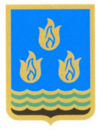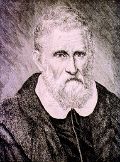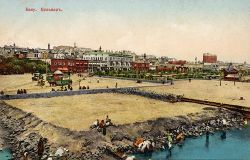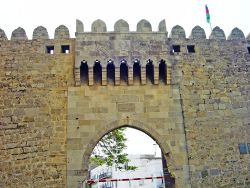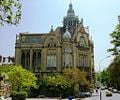Difference between revisions of "Baku" - New World Encyclopedia
Mike Butler (talk | contribs) |
Mike Butler (talk | contribs) |
||
| Line 79: | Line 79: | ||
[[Image:73 059 64737.jpg|thumb|right|250px|left|The first automobile in Baku. 1907.]] | [[Image:73 059 64737.jpg|thumb|right|250px|left|The first automobile in Baku. 1907.]] | ||
[[Image:Baku-boulevard.jpg|250px|right|thumb|Baku in the early 1900s.]] | [[Image:Baku-boulevard.jpg|250px|right|thumb|Baku in the early 1900s.]] | ||
| − | [[Image:Gosha gapi.jpg|250px|right|thumb|Gates to the | + | [[Image:Gosha gapi.jpg|250px|right|thumb|Gates to the Old City.]] |
Baku was inhabited during the [[Stone Age]], up to 100,000 years ago, and possibly a Bronze settlement existed there. Near Baku, in Gobustan, there were discovered Roman inscriptions dating from 84 C.E. to 96 C.E. | Baku was inhabited during the [[Stone Age]], up to 100,000 years ago, and possibly a Bronze settlement existed there. Near Baku, in Gobustan, there were discovered Roman inscriptions dating from 84 C.E. to 96 C.E. | ||
Revision as of 23:43, 18 July 2008
| Baku Bakı |
|||
|
|||
| Location in Azerbaijan | |||
| Coordinates: {{#invoke:Coordinates|coord}}{{#coordinates:40|23|43|N|49|52|56|E|type:city | |||
|---|---|---|---|
| name= }} | |||
| Country | Azerbaijan | ||
| Government | |||
| - Mayor | Hacıbala Abutalıbov | ||
| Area | |||
| - Total | 260 km² (100.4 sq mi) | ||
| Elevation | -28 m (-92 ft) | ||
| Population (2005)[1] | |||
| - Total | 2,036,000 | ||
| - Density | 7,830.76/km² (20,281.6/sq mi) | ||
| Time zone | AZT (UTC+4) | ||
| - Summer (DST) | AZT (UTC+5) | ||
| Postal code | AZ1000 | ||
| Area code(s) | 12 | ||
| Website: BakuCity.az | |||
Baku (Azerbaijani: Bakı), sometimes known as Baqy, Baky or Baki, located on the western shore of the Caspian Sea, is the capital, the largest city, and the largest port of Azerbaijan. Baku was the home of the world's first oil well, the world's first paraffin factory, and the world's first oil platform.[citation needed] The city was once captured by Turkish troops in World War I,[citation needed] and afterwards by Bolsheviks. Along with the surrounding area, the city was incorporated into the Soviet Union. Baku entered a period of decline after the break-up of the Soviet Union, but has since recovered.
Geography
The name Baku is derived from the old Persian Bagavan, which translates to "City of God". The folk etymology explains the name Baku as derived from the Persian Bādkube (بادکوبه ), meaning "city where the wind blows", due to frequent winds blowing in Baku. However, the word Bādkube was invented only in 16th to 17th centuries C.E., whereas Baku was founded at least before the fifth century C.E.
Located on the southern shore of the Absheron Peninsula, on the wide Bay of Baku, and sheltered by the Baku Archipelago, the coastal terrain around Baku lies as much as 92 feet (28 meters) below sea level. Around the city there are a number of mud volcanoes (Keyraki, Bogkh-bogkha, Lokbatan and others) and salt lakes (Boyukshor, Khodasan).
The climate is hot and humid in the summer, and cool and wet in the winter. During the winter gale-force winds sweep through on occasion, driven by masses of polar air. Strong northern winds (known as Khazri) and southern winds (Gilavar) are typical. Snow is rare, and temperatures on the coast rarely drop to freezing. The temperature for January is 33.8°F (1°C) and in July 82.4°F (28°C). The southwestern part of Great Baku is a more arid part of Azerbaijan, where precipitation is less than six inches (150mm) a year.
Land area totals 100 square miles (260 square kilometers).
During Soviet times, Baku was a vacation destination where citizens could enjoy beaches or relax in now-dilapidated spa complexes overlooking the Caspian Sea.
However, scientists consider the Apsheron Peninsula (including Baku and Sumqayit), and the Caspian Sea, to be the ecologically most devastated area in the world because of severe air, soil, and water pollution. Soil pollution results from oil spills, from the use of DDT as a pesticide, and from toxic defoliants used in the production of cotton.
Modern Baku consists of three parts: the Old Town (İçəri Şəhər), the boomtown, and the Soviet-built town.
The centre of Baku is the old town, which is also a fortress. In December 2000, the Inner City of Baku with the Palace of the Shirvanshahs and Maiden Tower became the first location in Azerbaijan classified as a World Heritage Site by UNESCO.
Most of the walls and towers, strengthened after the Russian conquest in 1806, survived. This section is picturesque, with its maze of narrow alleys and ancient buildings: the cobbled streets past the Palace of the Shirvanshahs, two caravansaries (ancient inns), the Maiden Tower, the baths and the Juma Mosque (it used to house the Carpet and Applied Arts Museum, but resumed its role as a mosque). The old town also has dozens of small mosques, often without any particular sign to distinguish them from the next building.
In 2003 , UNESCO placed the Inner City on the List of World Heritage in Danger, citing damage from a November 2000 earthquake, poor conservation as well as "dubious" restoration efforts. The Martyrs' Lane, formerly the Kirov Park, is dedicated to the memory of those who lost their lives during the Nagorno-Karabakh War and also to the 137 people who were killed on Black January, 1990.
Nearly every street that brings to mind anything related to the Soviet Union has been officially changed. More than 225 names of streets have been renamed since 1988; however, some people still use the old names. Namely, the first street ever to be built outside the Inner City, originally called Nikolayevskaya after Nicolas I, was renamed to Parlaman Kuchesi, because the Parliament of Azerbaijan Democratic Republic held its meeting in a building located at that street, then during soviet era it became Kommunisticheskaya Ulitsa and now is called İstiqlaliyyet Kuchesi (Azeri: "independence").
History
Baku was inhabited during the Stone Age, up to 100,000 years ago, and possibly a Bronze settlement existed there. Near Baku, in Gobustan, there were discovered Roman inscriptions dating from 84 C.E. to 96 C.E.
The apostle Bartholomew identified Baku as Albana. Local church traditions record the belief that Bartholomew's martyrdom occurred at the bottom of the Maiden Tower within the Old City, where a Christian church was built on the site of the pagan temple of Arta.
The fifth century historian Priscus of Panium mentioned the famous Bakuvian fires, the presence of which meant Baku became a center of ancient Zoroastrianism.
Shirvanshah rule
The earliest numismatic evidence found in the city is an Abbasid coin dating from the eighth century C.E. During this time Baku was a domain of the Arab Caliphate and later of Shirvanshahs, a Persianized dynasty of Arabic origin. The Shirvanshah established a native Azeri state and were rulers of Shirvan, a historical region in present-day Azerbaijan.
Baku frequently came under assault of the Khazars, a semi-nomadic Turkic people who dominated the Pontic steppe and the North Caucasus from the seventh to the 10th century. and starting from the 10th century, by the Rus, a medieval state centred on Kiev from 880 to the middle of the 12th centur.
Shirvanshah Akhsitan I built a navy in Baku, and in 1170, he successfully repelled another Russian assault. After a devastating earthquake struck Shamakhy, the capital of Shirvan in 1191 Shirvanshah’s court moved to Baku. A mint started to operate.
Hulagu Khan occupied Baku under the domain of the Shirvan state during the third Mongol campaign in Azerbaijan (1231-1239) and it became a winter residence for Ilkhanids.
Marco Polo (1254–1324) wrote of Baku oil exports to Near Eastern countries.
Between the 12th and the 14th centuries, The city walls were rebuilt and strengthened. The Maiden Tower, the castles of Ramana, Nardaran, Shagan and Mardakan, and also the famous Sabayel castle on the island of the Baku bay was built during this period. The rising level of the Caspian Sea engulfed much of the city and the famous castle of Sabayel went completely into the sea in 14th century.
In 1501, Safavid Shah Ismail I laid a siege on Baku. At this time the city was enclosed with strong walls which were washed by sea on one side and protected by a wide trench on land. In 1540, Safavid troops captured Baku again. In 1604, the Iranian shah Abbas I destroyed the Baku fortress.
Russians attack
Peter the Great of Russian captured Baku on June 26, 1723, after a lasting siege using cannons. The soldiers of two regiments (2382 people) were left in the Baku garrison. By 1730, successes of the Shah of Iran, Nadir Shah, (1698-1747) in Shirvan forced the Russians to make an agreement near Ganja on March 10, 1735, and Russian troops withdrew from the city.
In 1795, Baku was invaded by Agha Muhammad Khan Qajar (1742-1797) to defend against tsarist Russia's policy of subduing the South Caucasus. In the spring of 1796, Baku surrendered to General Zubov of Russia. General Pavel Tsitsianov was appointed the Baku's commandant. In March, 1797 the tsarist troops left Baku.
Russian forces, led by Tsitsianov, tried to besiege Baku during third Russo-Persian War (1804-1813). Tsitsianov tried to capture Baku on January 1806. He was killed in February 1806, by Huseyngulu khan of Baku near the city gates, during the presentation of the city’s keys to him. Baku was finally occupied by Russian forces led by General Bulgakov in September 1806, and Husayn Quli Khan was forced into exile.
Baku was absorbed into the Russian Empire after the Treaty of Gulistan in 1813. On July 10, 1840, the Baku uyezd was turned into an administrative region of the Russian Empire.
Oil exploited
In 1823, the world's first paraffin factory was built in the city, and in 1846, the world's first oil well was drilled in Bibi-Heybat. Javad Melikov from Baku had built the first kerosene factory in 1863. Large-scale oil development started in 1872, when the Russian imperial authorities auctioned the parcels of oil-rich land around Baku to private investors.
Within a short period of time Swiss, British, French, Belgian, German, Swedish and American investors appeared in Baku, among them were the firms of the Nobel brothers and Rothschilds, and industrial oil belt, better known as Black City, was established near Baku. Beginning from the 1890s, Baku provided 95 percent of the oil production in the Russian Empire and approximately half of world oil production. Within ten years, the city had become the foremost producer of oil overtaking the United States.
Medieval seaside fortifications were demolished in 1861 to allow for the creation of the port and a customs house in the quay. Baku became a center of the eponymous province after the devastating earthquake of 1859 in Shamakha.
World War I
In 1914-1917, Baku produced seven million tons of oil each year, totaling 28,683,000 tons of oil , which constituted 15 percent of world production at the time. Germany did not trust Turkey in oil matters and transferred General Friedrich Freiherr Kress von Kressenstein from the Middle Eastern front with his troops to Georgia in order to enter Baku, through Ukraine, the Black Sea and Georgia. Great Britain in February 1918, urgently sent General Lionel Dunsterville with troops to Baku through Anzali to block the German troops.
Bolshevik massacres
In 1917, after the October revolution, in the turmoil of the ongoing World War I (1914-1918) and breakup of Russian Empire, Baku came under the control of Baku Commune led by a veteran Bolshevik, Stepan Shaumyan (1878-1918). Seeking to capitalize on the existing inter-ethnic conflicts, by spring 1918, Bolsheviks inspired and condoned a civil warfare in and around Baku. During the infamous March Days, using the support of the Dashnak Armenian militia in the city, and under the pretext of suppressing the Musavat party, Bolsheviks attacked and massacred thousands of Azeris and other Muslims in Baku.
On May 28, 1918, the Azerbaijani faction of the Transcaucasian Sejm proclaimed the independent Azerbaijan Democratic Republic (ADR) in Ganja. Shortly after, Azerbaijani forces, with support of the Ottoman Army of Islam led by Nuru Pasha (1881-1949), started their advance onto Baku, eventually capturing the city from the loose coalition of Bolsheviks, Esers, Dashnaks, Mensheviks and the British forces under the command of General Dunsterville on September 15, 1918. Thousands of Armenians in the city were massacred in revenge for the earlier March Days.
Having been defeated, Turkey had to withdraw its forces from the borders of Azerbaijan in the middle of November 1918. Headed by General William Thomson, 5000 English soldiers arrived in Baku on November 17, and martial law was implemented.
Soviet control
In February 1920, the 1st Congress of the Communist Party of Azerbaijan legally took place in Baku and made a decision about preparation of the armed revolt. On April 28, 1920, the 11th Red Army invaded Baku and reinstalled the Bolshevik power. Baku became the capital of Azerbaijan Soviet Socialist Republic. Since 1921, the city was headed by the Baku City Executive Committee, commonly known in Russian as Bakgorispolkom.
On February 8, 1924, the first tram line and two years later the electric railway Baku-Surakhany—the first in the USSR—started to operate. The first buses appeared in Baku in 1928.
World War II
During World War II (1939-1945) Allied generals considered bombing Baku to wreck the supply of oil and thereby weaken the Soviet Union. During the Soviet-German War, 10 defense zones were built around the city to prevent possible German invasion, planned within the Operation Edelweiss. [Adolf Hitler]], the leader of Nazi Germany, said: "Unless we get Baku oil, the war is lost". During World War II the growing demand for oil pushed Baku oil workers to reach record levels of extraction — 23,482 million tons.
Post-war period
The first oil platform in the world, originally called "The Black Rocks," was built in 1947 within the city's metropolitan area. In 1960, the first Caucasus house-building plant was built in Baku, and on December 25, 1975, the only plant producing air-conditioners in the Soviet Union was turned over for operation.
In 1964–1968, the level of oil extraction rose to the stable level and comprised about 21 million tons per year. By the 1970s, Azerbaijan became one of the largest producers of grapes, and a champagne factory was subsequently constructed in Baku. In 1981, a record quantity of 15 billion cubic meters of gas was extracted in Baku.
In 1990, Shaumyan rayon of Baku was renamed to Khatai and Ordzhonikidze rayon to Narimanov. In 1991, following the collapse of the Soviet Union, and the Bakgorispolkom, the first independent city mayor Rafael Allahverdiyev was appointed. On April 29, 1992, the names of some more city rayons were changed:
Government
Azerbaijan is a presidential republic, in which the legislative and judicial branches have only limited independence. The president is an absolute ruler. Demonstrations are often suppressed with violence; there are reports of torture and a strong censorship exists. Although Azerbaijan is a member of human rights bodies, several independent bodies, such as the Human Rights Watch, have deemed human rights there to be sub-par at best. Democratic and personal freedoms have been diminished by the government, wary of revolutions in Central Asia spreading to home turf. Elections there have widely been contested as fraudulent and seriously flawed.
Baku is divided into eleven administrative districts, or raions (Azizbayov, Binagadi, Garadagh, Narimanov, Nasimi, Nizami, Sabail, Sabunchu, Khatai, Surakhany and Yasamal) and 48 townships. Among these are the townships on islands in the Baku Bay and the town of Oil Rocks built on stilts in the Caspian Sea, 60km away from Baku.
Economy
Overview – Any specialization: For instance, is a manufactured product is associated with particular cities a. Milwaukee—cheese and beer b. Los Angeles—entertainment industry c. Sheffield—coal d. top 20 cities in the U.S. are highly specialized
Per capita GDP, rank Financial and business services sector Tourism Manufacturing Transport: Road, rail, air, sea
The basis of Baku's economy is petroleum. The existence of petroleum has been known since the 8th century. In the 10th century, the Arabian traveler, Marudee, reported that both white and black oil were being extracted naturally from Baku[1]. By the 15th century oil for lamps was obtained from hand dug surface wells. Commercial exploitation began in 1872 , and by the beginning of the 20th century the Baku oil fields were the largest in the world. Towards the end of the 20th century much of the onshore petroleum had been exhausted, and drilling had extended into the sea offshore. By the end of the 19th century skilled workers and specialists flocked to Baku. By 1900 the city had more than 3,000 oil wells of which 2,000 of them were producing oil at industrial levels. Baku ranked as one of the largest centres for the production of oil industry equipment before WWII. The World War II Battle of Stalingrad was fought to determine who would have control of the Baku oil fields. Fifty years before the battle, Baku produced half of the world's oil supply: Azerbaijan and the United States are the only two countries ever to have been the world's majority oil producer. Currently the oil economy of Baku is undergoing a resurgence, with the development of the massive Azeri-Chirag-Guneshli field (Shallow water Gunashli by SOCAR, deeper areas by a consortium lead by BP), development of the Shah Deniz gas field, the expansion of the Sangachal Terminal and the construction of the BTC Pipeline. The old Inturist Hotel was one of Baku's largest, now being renovated, but overshadowed by the newer Hyatt Park, Hyatt Regency, Park Inn and Excelsior.
Baku Stock Exchange has been operating since February 2001.
Infrastructure
Bulk power supply of Baku is provided by five 110 kV lines. As of February 8, 2008 three of them (total length 23,6 km) have been completely refitted and modernized with their carrying capacity being doubled.[2] Three 110 kV and twelve 35 kV substations were commissioned recently.[2] Water supply is secured by several lines, the purest water comes from Khachmaz and Shollar lines.[3]
Transport and communication
Baku is served by the Heydar Aliyev International Airportand the Baku Metro. There were once also trams. There are two official taxi companies in the city: the yellow Star cabs and the white taxis with blue sign from "Azerq Taxis". The van buses stop at any point along that route when flagged down or told to stop. Shipping services operate regularly from Baku across the Caspian Sea to Turkmenbashi (formerly Krasnovodsk) in Turkmenistan and to Bandar Anzali and Bandar Nowshar in Iran. The city's main Internet providers are ADaNet and AzInternet Services.
Demographics
As of January 1, 2005 the population was 2,036,000 of which 153,400 were internally displaced persons and 93,400 refugees.
Race/ethnicity - historical background of ethnic groups Language
Religion
More than 94% of the residents of Baku practice various forms of Islam (vast majority Shia). A small minority of the population (about 4%) are Christians (majority Russian Orthodox Church, Georgian Orthodox Church and Molokans). Baku also has three different Jewish communities, namely the Ashkenazim Jews, the Mountain Jews, and the Georgian Jews.
Education
As Azerbaijan's centre of education, Baku boasts many universities and vocational schools. After Azerbaijan gained independence, the fall of Communism led to development of a number of private institutions. Baku also houses the Academy of Sciences of Azerbaijan founded here in 1945 .
Public universities include: *Azerbaijan Medical University (founded 1930)
- Azerbaijan State Economic University (1930)
- Azerbaijan State Oil Academy (1920)
- Azerbaijan Technical University (1950)
- Azerbaijan University of Languages (1973)
- Azerbaijan Architecture and Construction University (1975)
- Baku Academy of Music (1920)
- Baku Slavic University (1946)
- Baku State University (1919)
Private universitiesinclude:*Azerbaijan International University (1997)
- Khazar University (1991)
- Odlar Yurdu University (1995)
- Qafqaz University (1992)
- Western University (1991)
xxxx Until 1988 Baku had very large Armenian, Russian, and Jewish population that contributed to cultural diversity and added in various ways (music, literature, architecture) to Baku's history treasure chest. Under Communism, the Soviets took over the majority of Jewish property in Baku and Kuba. Since the collapse of the Soviet Union, Azerbaijani President Heydar Aliev has returned several synagogues and a Jewish college nationalized by the Soviets, to the Jewish community. He has encouraged the restoration of these buildings and is well-liked by the Jews of Azerbaijan. Renovation has begun on seven of the original eleven synagogues, including the Gilah synagogue, built in 1896, and the large Kruei Synagogue.[4]. The new Azerbaijan constitution grants religious freedom and asserts that there is no state religion.
Currently vast majority of the population of Baku are ethnic Azerbaijanis (more than 90%). The intensive growth of the population started in the middle of the 19th century when Baku was a small town with the population of about 7 thousand people all in all. The population increased again from about 13,000 in the 1860s to 112,000 in 1897 and 215,000 in 1913, making Baku the largest city in the Caucasus region.[5]
Baku has been a cosmopolitan city at certain times during its history, meaning ethnic Azerbaijanis did not constitute the majority of population. [6]
| Year | Armenians | Azerbaijanis | Georgians | Iranian Citizens | Jews | Russians | Total |
|---|---|---|---|---|---|---|---|
| 1897 | 19,060 | 40,148 | 971 | 9,426 | 2,341 | 37,399 | 111,904 |
| 1903 | 26,151 | 44,257 | N/A | 11,132 | N/A | 56,955 | 155,876 |
| 1913 | 41,680 | 45,962 | 4,073 | 25,096 | 9,690 | 76,288 | 214,672 |
Entertainment
Baku has a vibrant life regarding theatre, opera and ballet, drawing both from the rich local dramatic portfolio and from the international repertoire. The main movie theatre is "Azerbaijan Cinema". The Azerbaijan State Academic Opera and Ballet Theatre, designed by architect N. G. Bayev, is one of the most ornate music halls in the city. The State Philharmonic Hall with excellent acoustic conditions often holds performances outside, in a pleasant park. The Carpet and Applied Arts Museum exhibits the carpets from all periods, styles and from both Azerbaijan proper and the Azeri provinces in Iran. Baku also houses country's biggest art museum - Azerbaijan State Museum of Art, a depository of both domestic and foreign works of art, Western and Eastern.
Heydar Aliyev Palace is one of the main venues featuring sizeable performances (e.g. that of Coolio), though it is currently closed for a major refurbishment. Some of the most popular discotheques and night clubs include, "X-Site", "Capitol Night Club", "Le Chevalier" at Europa Hotel, "Zagulba Disco Club" and "Le Mirage". Most of them are open till the early hours of the morning. The "Capitol Night Club" is a lively night spot with gay elements, playing a blend of local, Russian and Western music, R&B, trance, europop and techno.
Most of the pubs and bars are located near Fountain Square and are usually open until the early hours of the morning. There are several British and Irish style pubs, among them "Corner Bar", "Shakespeares", "Finnigans" the "Rig Bar", "O'Malley's" and the "Phoenix Bar". There is also a Jazz Club. The Baku International Jazz Festival is organized annually.
Notable beaches include Shikhovo and "One Thousand and One Nights".
Famous people from Baku
Because of intermittent periods of great prosperity and as the largest city in the Caucasus and one of the most ethnically and culturally diverse in the Soviet Union, Baku prides itself on having produced a disproportionate number of notable figures in the sciences, arts and other fields. Some of the houses they resided in display commemorative plaques.
Science
- Abbasgulu Bakikhanov, philosopher
- Kerim Kerimov, one of the founders and head of Soviet space program for 25 years
- Lev Landau, physicist, winner of the Nobel Prize in Physics of 1962
- Lotfi Zadeh, inventor of fuzzy logic
- Max Black, philosopher
Music
- Bul-Bul, singer.
- Polad Bul-Bul oglu, singer.
- Fikret Amirov, composer.
- Alexey Ekimyan, composer and police general.
- Artemi Ayvazyan, composer and conductor.
- Gara Garayev, composer.
- Uzeyir Hajibeyov, composer.
- Muslim Magomayev, famous opera and pop singer.
- Vagif Mustafazadeh, iconic Soviet jazz pianist, composer.
- Alim Qasimov, Mugham singer (a nearby village).
- Mstislav Rostropovich, cellist.
- Lutviyar Imanov,famous opera singer.
- Larisa Dolina, Russian pop singer
Literature and Arts
- Sattar Bahlulzade, painter
- Huseyn Javid, poet and playwright
- Mikayil Mushfig, poet
- Lev Nussimbaum, writer, author of the best-selling novel "Ali and Nino"
- Tahir Salahov, painter and draughtsman
Chess
- Garri Kasparov, grandmaster and world champion
- Elmar Magerramov, grandmaster
- Teimour Radjabov, grandmaster
- Emil Sutovsky, grandmaster
- Tatiana Zatulovskaya, grandmaster
Entertainment
- Rasim Ismaylov, film director and writer
- Rustam Ibrahimbeyov, screenwriter and Academy Award winner
- Magsud Ibrahimbeyov, writer
- Murad Ibrahimbeyov, film director
- Abbas Sharifzadeh, actor and director
- Vladimir Menshov, Academy Award winning film producer.
- Sergo Zakariadze, actor
- Henry David, actor
Business
- Vagit Alekperov, founder of the leading Russian oil company LUKOIL
- Murtuza Mukhtarov, oil industrialist and millionaire
- Musa Nagiyev, industrial magnate in late 19th - early 20th century
- Zeynalabdin Taghiyev, industrial magnate and philanthropist
Politics
- Khalilullah I, (1417-1465), ruler of Shirvan
- Mammed Amin Rasulzade, politician, founding father of Azerbaijan Democratic Republic
- Georgy Shakhnazarov, Soviet political scientist
- Alimardan Topchubashev, politician, foreign minister of Azerbaijan Democratic Republic
Military
- Ziya Bunyadov, Hero of the Soviet Union and Academician
- Mehdi Huseynzade, Hero of the Soviet Union
- Rafael Kapreliants (Gabrielyan), Hero of the Soviet Union
- Musa Manarov, cosmonaut
- Samedbey Mehmandarov, Russian tsarist general, Minister of Defense of Azerbaijan Democratic Republic
- Ali-Agha Shikhlinski, Russian tsarist lieutenant-general, Deputy Minister of Defense of Azerbaijan Democratic Republic
- Richard Sorge, famous Soviet spy
Gallery
- Philarmonia.jpg
Philharmonic Hall
- BakuOpera.jpg
Opera
- Incesenet Müzesi.jpg
Museum of Art
- BakuKidsTheather.jpg
Puppet Theatre
- Baku002.jpg
Nizami Cinema
- Baku41.jpg
Baku Academy of Music
- Azerbaijan National Petrol Building.jpg
New office building
- Baku Maiden Tower.jpg
Maiden Tower
- BakuStreet1.jpg
Street in oil boom-era Baku
- Bank Standart.jpg
Renovated office of Bank Standard
- 1941-45 monument.jpg
Monument to Azeri participants on the Eastern Front of WWII
See also
- Baku Photo Gallery
- Second Baku
- Baku-Tbilisi-Ceyhan pipeline
- Bāgh
ReferencesISBN links support NWE through referral fees
- ↑ Population estimates for Baku, Azerbaijan, 1950-2015. Retrieved 2007-07-15.
- ↑ 2.0 2.1 (Russian)Выполненные ОАО "Бакыэлекрикшебеке" обеспечивают стабильность электроснабжения Баку. Retrieved 2008-03-07.
- ↑ (Russian)Институциональные аспекты управления и охраны водных ресурсов в Азербайджане. Retrieved 2008-03-07.
- ↑ JewishVirtualLibrary.org
- ↑ Country-data.com
- ↑ Audrey Altstadt, Conflict, Cleavage, and Change in Central Asia and the Caucasus, Cambridge University Press, 1997, p. 112, table 4.1, Ethnic composition of Baku, 1897, 1903,1913
- Abbasov, Mazakhir. Baku During the Great Patriotic War.
- Madatov, G. Azerbaijan During the Great Patriotic War. Baku, 1975.
- Michael Smith. "Anatomy of Rumor: Murder Scandal, the Musavat Party and Narrative of the Russian Revolution in Baku, 1917-1920", Journal of Contemporary History, Vol 36, No. 2, (Apr. 2001), p. 228.
- Furuz Kazemzadeh, Struggle For Transcaucasia (1917 - 1921), New York Philosophical Library, 1951, p. 143-144
External links
- Travel guide to Baku from Wikitravel
- Azerbaijan travel information
- UNESCO World Heritage Site listing Walled City of Baku
- Baku Pages
- Baku hotels directory
- Baku Hotels
- American Embassy in Baku Azerbaijan
- British Embassy in Azerbaijan
- Baku travel guide and photos
- Azerbaijan Satellite view (Google Maps)
- Building projects and real estate development in Baku
Credits
New World Encyclopedia writers and editors rewrote and completed the Wikipedia article in accordance with New World Encyclopedia standards. This article abides by terms of the Creative Commons CC-by-sa 3.0 License (CC-by-sa), which may be used and disseminated with proper attribution. Credit is due under the terms of this license that can reference both the New World Encyclopedia contributors and the selfless volunteer contributors of the Wikimedia Foundation. To cite this article click here for a list of acceptable citing formats.The history of earlier contributions by wikipedians is accessible to researchers here:
The history of this article since it was imported to New World Encyclopedia:
Note: Some restrictions may apply to use of individual images which are separately licensed.
